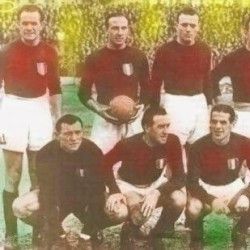
Calcio: The story from the other side of Turin

Football in Turin is somewhat of a one-sided affair. Juventus and Torino have maintained themselves as the two most appealing clubs from the city for sometime now, but the Old Lady have almost become synonymous with the sporting culture in the city. But there is more to Turin than just the glitz and fame of the Bianconeri. FC Torino, the cross town rivals of the Old Lady, are currently lingering around the bottom half of the Serie A Table. The clarets are miles behind their rivals when it comes to quality or having strength in depth, but are not far behind when it comes to having a glorious past. FC Torino boast of having produced one of the best teams in Italian football. A team that set the tone for Italian Football for years to come.
May 4th 1949 was a horrendously grey and wet day in Turin. Dark clouds enveloped the hills that surround the town, and by afternoon, streaks of thunder roared around the hills. Yet the people in the town were waiting in anticipation of their heroes to return after bidding farewell to a close friend of the captain of FC Torino. The club were on the verge of sealing what would be their 5th consecutive Scudetto. As the news of the Fiat G-212 bursting out into flames spread, the words of Vitorio Pozzo, quivering with grief and disbelief, turned the country into a state of mourning.
“The Torino team is no more… it has disappeared…it is burnt…it has exploded”
The takeover of the club by eminent industrialist Ferruco Novo in 1939 marked the beginning of a golden period in the club’s fortunes. The team was slowly built, by carefully placing brick after brick after brick. Novo was a pioneer in the field of football scouting – he was probably amongst the first in the footballing sphere to send specialist scouts to monitor kids who played their football on the streets and to also keep constant checks on the dissatisfied players from other clubs. Slowly but surely, Novo was building his own brainchild, which would eventually be termed as ‘Grande Torino.’ The immaculate success of the club is greatly attributed to its president. He built a team of experts in the sport who would help him run the club in the appropriate manner, and who would help him translate his experience in the leather industry to the football pitch. Such presidents were a novelty then, and are a rarity now.
Torino were the defining club of the 40′s, a club that were years ahead of its time. When we talk about the people that mattered most for the club during those times, the role of Erno Erbstein has to be given a mention. The Hungarian manager was considered by many as Ferruccio Novo’s best advisor and the man behind Torino’s success. During his first stint at Torino in 38/39 season, he became close friends with the newly appointed president. When Italy adopted anti-Jewish laws, Erbstein was forced to return to Hungary, but still remained in close touch with the Torino president. He provided Novo with many useful advices, including the ones concerning the signing of Mazzola and Loik. After the war, Erbstein was officially appointed as technical manager of a team and later in 1948, he became assistant coach.
At a time when the European continent was gripped by the shackles of the second World War, the people of Italy needed moral support and upliftment. Football in Italy during those times was one of the major sources of entertainment for the population. After being enthralled by the Golden Team of the 20′s led by Guiseppe Meazza, it was time for the followers of the sport to be amazed by Valentino Mazzola and his team of the 40′s.
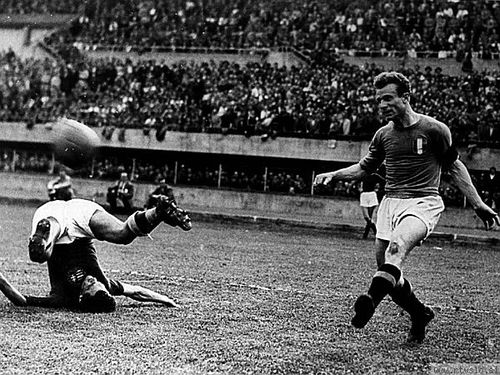
Valentino Mazzola – The heart-throb of Turin
The team adopted a free-flowing style of attacking and attractive football which always brought a smile to the glum faces in the stands. Captained by the great Valentino Mazzola, their inspirational leader and the first truly modern midfielder, Torino revolutionized the game. Such was the creativity and ingenuity of the team’s football that they are even partly thought to have inspired the concept of “Total Football” championed by the Dutch in the 1970s. But it wasn’t just Mazzola who made the team so special. Romeo Menti, the right forward, possessed flair and pace in abundance. Loik and Mazzola played as the inside forwards, and formed the famous ‘square’ in midfield alongside Guiseppe Grezar, who marshalled his troops, and Castigliano, the play-maker.
The defence was led by the sturdy Mario Rigamonti, the center half. He was ably supported by the fiercely combative Aldo Ballarin at right half back, and the skillful wing-back Maroso, who is still rated highly by experts on the basis of his supreme technical ability. Such defenders during those times still remain a perplexing concept. The system adopted by the team under its different managers remained the same, which speaks volumes about the incredible chemistry instilled within the ranks. The formation of the team never remained constant. The team continuously switched between a 3-4-3 and an attacking variant of the 4-4-2, in which the inside forwards played as central midfielders. The team played with fluidity: each player moved a lot on the pitch, they often switched positions, since all players were equally adept at playing different positions.
Click on image to enlarge:
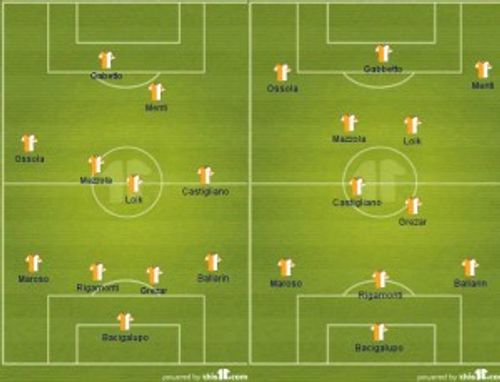
On the left – The 4-4-2
O the right – the 3-4-3
The 3-4-3 often turned into a 4-4-2 and vice versa. As it is seen, Grezer, the enforcer, often dropped back at center half alongside Rigamonti, to form a 4 man backline. Mazzola would switch positions from the Inside Left channel to Central Midfield to slot in alongside Loik. Castigliano, the deep lying playmaker, would switch positions to the right flank, and Menti, the right wing forward, would move centrally to play behind the prolific hitman, Gabbetto. To simplify matters, here is an arrow board which depicts all movement:
Click on image to enlarge:
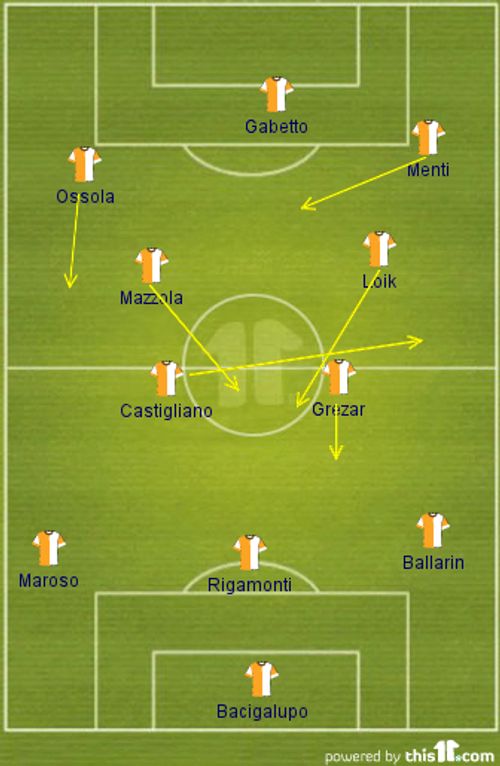
Movements of players in a formation change from the 3-4-3 to the 4-4-2
However, the player who stood out from the rest was the captain of Grande Torino, Valentino Mazzola. Standing at 1.70m tall, the elegant midfielder was best known for his stellar left foot and his ability in the air. His rhythm disarmed most markers. Speedy for someone so robust, he regularly outpaced his rivals. In a matter of minutes, he was in defense and later in attack. Shirt pulls, body shoves or literal pushing could not stop a Mazzola on fire.
Just as when the path ahead seemed to be a bed of roses, disaster struck. The Fiat G-212, which was carrying the team back to Turin from Lisbon, burst into flames at Superga. All thirty-one people on board, including eighteen members of the squad, along with the trainers, members of staff, accompanying journalists and the plane’s crew, died.
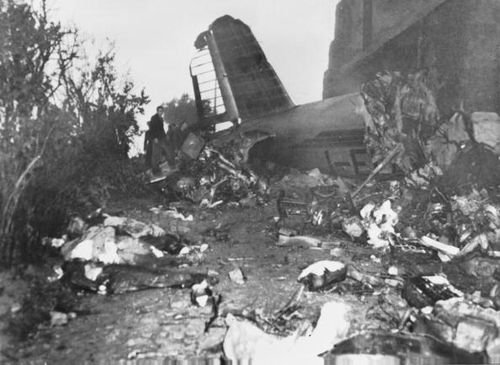
The country went into a state of mourning following the horrendous mishap. At a time when the country was distraught by the shackles of war and death, Grande Torino meant much more than a team to the people. The funerals of the deceased were held two days later on what was another miserably cold and wet day – which was symbolic of the state of the country and its people. Over half a million people lined the streets to catch a glimpse of the funeral procession, and bid a final farewell to their departed heroes. Over 30,000 people gathered at Superga to play their homage to the team that was no more. Torino fielded their youth team for the remaining fixtures and were rightly awarded the Scudetto.
The Superga disaster left Calcio in ruins, and left a deep scar on the mentality of the nation. The trauma that people underwent was unthinkable. All forms of air transportation were brought to a halt. Even the Italian National team completed their journey to the 1950 World Cup in Brazil by a boat, which took its toll on their fitness. Italy exited the tournament after just playing for 90 minutes.
It becomes hard to gauge the measure of greatness which the magical side from Turin would have achieved had Superga not taken place. With all players hardly in their mid 20′s, it would be plausible to assume that with the formation of the European Cup in 1955, it would have been Torino, and not Real, who would have dominated proceedings on the continental front. Robbed of their lives and denied the chance to fulfil their potential, Grande Torino became a legend, one which is narrated by fondness as well as sorrowful remembrance, today.